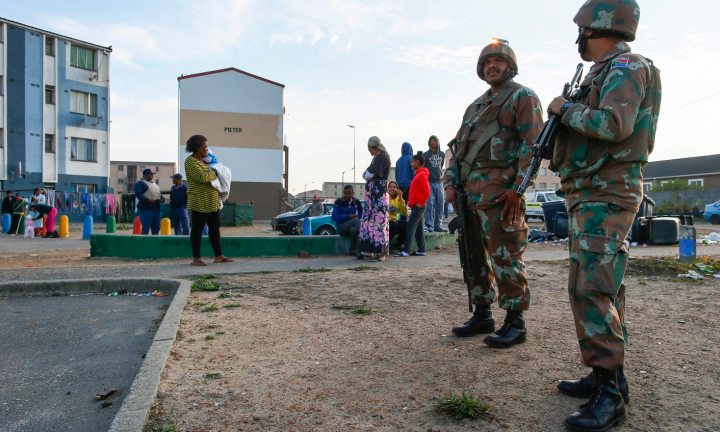South Africa
Where murder happens in South Africa

Most murders are not random. Some people are more at risk than others. Lizette Lancaster explains where murder happens, why location matters and what it means for tackling crime. By AFRICA CHECK.
Published courtesy of Africa Check and Institute for Security Studies
Over the past three years the South African murder rate has increased from 30 murders per 100,000 to 33. This is five times higher than the global average of 6.2 per 100,000. According to the United Nations Office on Drugs and Crime, South Africa ranked eight out of 167 countries with data available for 2012.
Between April 2014 and March 2015, on average 49 people were murdered each day. This is on average two more killings a day than in the previous year and a staggering six more deaths a day than in 2011/12.

The 2013/14 South African Police Service annual report showed that 5% of murder victims were children and 14% were women, most of whom were murdered by their intimate partners. By far the majority of victims (81%) were male. Victimisation surveys, police docket surveys and mortuary surveillance studies confirm young black men are most at risk of falling victim to murders.
Western Cape tops the list
Most murders do not make the news. They happen in places where violence and crime is a daily occurence and where desperate and marginalized residents are routinely overlooked by media and politicians.
Research shows that murders are often not premeditated, but take place when an argument leads to physical assault. Most victims are killed by acquaintances, friends or family members during disputes that are often fuelled by alcohol.
The Western Cape, Eastern Cape, KwaZulu-Natal, Northern Cape and the Free State were the five most dangerous provinces as far as murder were concerned in 2014/15. All had a murder rate higher than the national rate of 33 per 100,000 people. Gauteng, North West, Mpumalanga and Limpopo had murder rates below the national average.
Risk also varies within cities
In recent years, police have recorded more murders in Cape Town than in Johannesburg and Pretoria combined. This means that taking population into account, Cape Town residents are almost twice (1.8 times) more likely to be murdered than Johannesburg residents.
But the risk of becoming a victim of crime depends a significant degree on your race, gender, age, economic status and where you live. For example, almost two-thirds of the Cape Town murders took place in just ten of the sixty police station precincts in the city, according to a crime hotspot analysis we carried out at the Institute for Security Studies (ISS).
The Nyanga, Harare, Mitchellsplain, Gugulethu, Khayelitsha and Delft police precincts remain the most murderous in the peninsula. These areas have experienced extremely high murder rates for more than a decade, suggesting that the cycles of violence will be difficult to break.
There are such vast differences in risk between areas that half of South Africa’s murders in 2014/15 occurred in only 12.3% of police precincts. On the other hand, one in five police stations in predominantly affluent metro and rural areas and towns have a murder rate of less than 12 per 100,000. Just over 10% of policing precincts have a murder rate of zero.
Murder accounts for less than 3% of all violent crime
As high as the murder rate is, murder accounts for less than 3% of all violent crime. While there were 17,805 murders last year, almost 600,000 other violent crimes – including attempted murder, rape, robbery and assault – were recorded by the police.
Central business districts and mixed residential and business nodes in large urban and metro areas remain the most high-risk areas in terms of violence in general, and specifically for robberies. The clear front-runner is Mitchells Plain followed by Johannesburg Central, Hillbrow, Nyanga, Pretoria Central, Umlazi and Khayelitsha.
Violence can be prevented
Violence affects everybody in some way. The trauma of witnessing or experiencing violence has lasting physical and emotional consequences and a significant impact on economic growth.
Violence can be prevented, but it requires a comprehensive strategy which would include integrated short-, medium- and long-term inventions and responses. Such a strategy should guide not only the police but other government departments, civil society organisations and the public.
Long-term interventions may not be easy to sell to the crime-weary public and politicians who want quick wins. However, the implementation of long-term strategies is vital if we wish to reduce violence.
These would include interventions which focus on supporting parents, reducing the exposure of children to violence and keeping children in school.
The increases in many violent crime categories in recent years point to the need for urgency in adopting a new approach to violence prevention. The National Development Plan calls for a re-think on building community safety in the medium to long-term. The implementation of this plan needs to be fast-tracked if thousands of lives are to be saved. DM
Lizette Lancaster is manager of the Crime and Justice Information Hub in the Governance Crime and Justice Division of the Institute for Security Studies.
Photo: Operation Fiela in Cape Town (EPA)
Additional Reading
-
GUIDE: Understanding crime statistics in South Africa – what you need to know
-
FACTSHEET: South Africa’s 2014/15 assault and sexual crime statistics
-
FACTSHEET: South Africa’s 2014/15 murder and robbery crime statistics

















 Become an Insider
Become an Insider